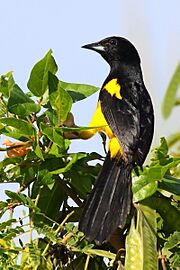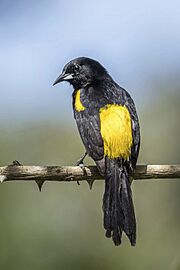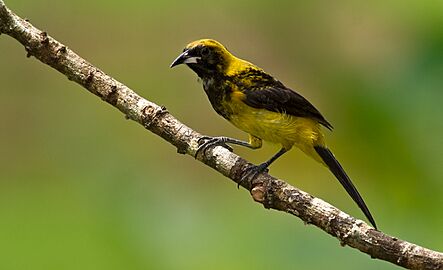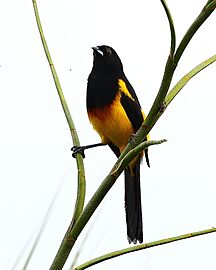Black-cowled oriole facts for kids
Quick facts for kids Black-cowled oriole |
|
|---|---|
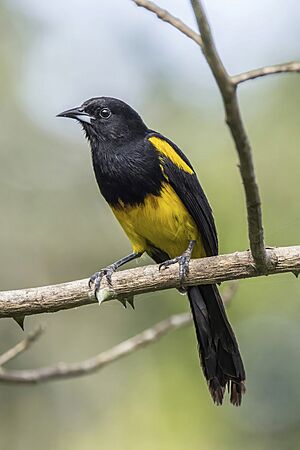 |
|
| I. p. prosthemelas in Belize |
|
| Conservation status | |
| Scientific classification | |
 |
|
| Range | |
| Synonyms | |
|
The black-cowled oriole (Icterus prosthemelas) is a colorful bird found in Central America. It belongs to the Icteridae family, which includes orioles and blackbirds. This bird is quite common and lives in the warm, low-lying areas and hills near the Caribbean Sea. Its home stretches from southern Mexico all the way to western Panama.
You can find black-cowled orioles in many places. They like humid forests, but also clearings, forest edges, and even gardens. They are often seen in areas with scattered trees and bushes. Adult male orioles are mostly black. They have bright yellow patches on their belly, shoulders, and rump. The yellow also shows under their wings and near their tail.
Female orioles can look different depending on where they live. In the southern parts of their range, females look a lot like the males. But in the north, females have an olive-yellow head and back. Their face, throat, upper chest, wings, and tail are black.
These birds mostly look for food in the middle parts of trees. They eat a mix of insects, spiders, fruit, and sweet nectar from flowers. Female orioles build a special hanging nest. They lay three eggs in this shallow nest, which is stitched to the underside of a large leaf. Both parents work together to protect the nest and feed their young.
Because there are so many black-cowled orioles and their numbers seem steady, experts consider them a species of "least concern." This means they are not currently at risk of disappearing.
Contents
Bird Basics: What is a Black-Cowled Oriole?
The black-cowled oriole was first described in 1850 by an English bird expert named Hugh Strickland. For a while, some scientists thought it was the same species as other orioles found on islands like Hispaniola. However, newer studies showed that it is indeed its own unique species.
Naming the Oriole: Taxonomy and History
When Hugh Strickland first described this bird, he called it Xanthornus prosthemelas. Later, in 1856, another scientist named Philip Sclater moved it to the genus Icterus, which is where most orioles are placed. For many years, it was seen as a separate species.
In 1947, a bird expert named James Bond (not the spy!) grouped it with other oriole species from the Caribbean islands. He thought they were all the same species, Icterus dominicensis. But studies done after 2000 looked at the birds' genetics. These studies proved that the black-cowled oriole is quite different from the island species. So, it was given its own full species status again. These same studies also showed that its closest relative is the orchard oriole.
Scientists recognize two slightly different types, called subspecies, of the black-cowled oriole. They mainly differ in how their young birds look:
- I. p. prosthemelas: This type was described in 1850 and lives from Mexico down to central Costa Rica.
- I. p. praecox: This type was described in 1965 and is found from southeastern Costa Rica to western Panama.
The name Icterus comes from an ancient Greek word, ikteros, which means "yellow bird." The second part of its scientific name, prosthemelas, is also from Greek. Prosthen means "front," and melas means "black." So, its name basically means "black in front," referring to its black head. In the past, it was also known as Lesson's oriole.
Appearance: What Does the Oriole Look Like?
The black-cowled oriole is a medium-sized passerine bird, which means it's a perching bird. It measures about 18.5 to 21 centimeters (about 7 to 8 inches) long. Male orioles are a bit bigger and heavier than females. Males weigh around 32.5 grams (about 1.1 ounces), while females weigh about 27.5 grams (about 1 ounce).
Male and Female Differences
In the northern parts of its range, male and female black-cowled orioles look quite different. This is called sexual dimorphism. However, in the southern areas, their feathers are very similar. Both males and females have a thin, slightly curved black bill. The bottom part of the bill is silvery.
The adult male is mostly black. It has bright yellow patches on its shoulders, rump, and the feathers covering its upper tail. The feathers under its wings, on its lower chest, thighs, and near its tail (called the crissum) are completely yellow. There's also a narrow band of chestnut color where the black and yellow meet on its chest.
Where the female's feathers are different, she has a black face, throat, and upper chest. Her head and upper body are olive-yellow. Some females, especially further south, might have a mix of black and yellow feathers on their head and back. Others might have completely black heads, or even look exactly like males. Both sexes have blue-gray legs and feet, and brown eyes.
Young Orioles
Young I. p. praecox orioles are dull yellow-olive on top and dull yellow underneath. The feathers on their back have black bases that sometimes show through. Their face, forehead, throat, wings, and tail are a dull black. They keep these feathers for about a year.
Oriole Sounds: Calls and Songs
The black-cowled oriole's song is usually quiet. It's a complex mix of soft, whistled notes and harsher chattering sounds. People describe these sounds as clear, metallic, slurred, and mellow. The bird seems to sing them in a random order.
Its calls include a scratchy, rising weet, a nasal deep, and a quiet tee-u. When the bird feels threatened, it makes scolding sounds like sharp cherp and chep notes. These can sound like cheh-cheh-cheh-chek or churr'churr'churr, sometimes mixed with parts of its song.
Spotting the Difference: Similar Birds
Young black-cowled orioles can look like the yellow-tailed oriole or young orchard orioles. However, you can tell them apart because the black-cowled oriole has a completely black tail and no wing bars (stripes on the wings). It's also bigger than an orchard oriole but much smaller than a yellow-tailed oriole.
Even though the black-cowled oriole looks similar to the black-vented oriole, they live in different places and habitats. The black-vented oriole prefers dry, high-altitude areas. It is also larger, heavier, and has a longer tail. Its crissum is black, its belly is orangey-yellow, and its beak is longer and straighter. Young black-vented orioles also have less black on their face than young black-cowled orioles.
Female and young black-cowled orioles might also be confused with the yellow-backed oriole. But the yellow-backed oriole is brighter yellow on its head and back, has less black on its face, and a thicker, straighter bill. They can also look like the female bar-winged oriole. However, the bar-winged oriole usually lives on the Pacific side of Central America and often has lighter wings and tail, plus a pale wing bar. Finally, Audubon's oriole is rarely found in the same places. It is larger, with a heavier, straight beak.
Where the Oriole Lives: Distribution and Habitat
The black-cowled oriole lives across much of eastern Central America. Its range goes from southern Mexico all the way through western Panama. It prefers the Caribbean lowlands and foothills. You can find it from sea level up to about 1,300 meters (about 4,265 feet) high, but it mostly stays below 500 meters (about 1,640 feet). It's quite common in these areas.
In the early 2000s, this bird started to spread its range. It began appearing on the Pacific side of Costa Rica, with some sightings in the central and southern lowlands. It lives in humid and semi-humid forests, including open areas and along the edges of forests. It also likes more open places with scattered bushes and trees. In forested areas, you'll often find it near rivers or streams. It especially likes open woodlands and plantations, like banana farms. It's often seen around palm trees. In the southern part of its range, it prefers more open habitats, such as gardens and areas where forests are regrowing.
Oriole Life: Behavior and Ecology
The black-cowled oriole is a resident species. This means it doesn't migrate or travel long distances. It stays in the same area all year round. You usually see these birds moving around in pairs or small groups. They often join up with other bird species in mixed flocks, and they regularly mix with other types of orioles. At night, they roost (rest) in loose groups in tall grass. Young orioles sometimes travel together in their own flocks.
Building a Home: Breeding and Nesting
Black-cowled orioles are thought to be monogamous, meaning a male and female pair up for breeding. They build a shallow, hanging nest, which is usually about 8 centimeters (about 3 inches) deep. The nest is typically placed about 1.5 to 10.5 meters (5 to 35 feet) above the ground.
They make their nests from thin, light-colored fibers. They usually hang the nest from the strong central vein of a large leaf, like those from heliconia plants, palms, or banana trees. Sometimes, they use a fold at the edge of a leaf instead. The oriole pokes holes in the leaf and weaves fibers through them to hang the nest securely. Occasionally, pairs might even build their nests under the eaves of a house, hanging them from nails or wires.
Black-cowled orioles usually breed alone. However, pairs in the Yucatán Peninsula sometimes build their nests near or even within colonies of orange orioles. The female lays three eggs. These eggs are white with brown speckles and are about 23 millimeters (about 0.9 inches) long. Both the mother and father bird work together to protect the nest. They also both sit on the eggs to keep them warm and feed the baby birds once they hatch.
What's for Dinner: Feeding Habits
The black-cowled oriole eats a varied diet. It enjoys arthropods (like insects and spiders), fruits, and nectar from flowers. It searches for its prey by poking and prodding among plant leaves. Sometimes, it even hangs upside down to grab insects from the underside of leaves.
It usually looks for food in the middle parts of trees, often in palm trees. It eats fruits from many different trees, including Cecropia species, Talisia olivaeformis, Ehretia tinifolia, Stemmadenia donnell-smithii, Bursera simaruba, and Trophis racemosa. It also sips nectar from the flowers of various epiphytes (plants that grow on other plants), like Columnea species. It also gets nectar from tree flowers such as Bernoullia flammea, various Inga species, bananas, and Erythrina costaricensis. While drinking nectar, the orioles help to pollinate these plants.
Oriole Health: Status and Threats
The International Union for Conservation of Nature (IUCN) has evaluated the black-cowled oriole. They consider it a species of "least concern." This is because it has a very large range and its population numbers seem to be stable.
Estimates from Partners in Flight suggest there are between 50,000 and 499,000 individual black-cowled orioles. There is no clear evidence that their numbers are going down or that they face serious threats. However, because of their beautiful colors, people in Costa Rica sometimes catch and keep these birds as pets.
Black-cowled orioles can also become prey for other animals. They react to the sounds of the ferruginous pygmy owl, which suggests they see this owl as a danger. Roadside hawks have been seen catching black-cowled orioles in flight several times. Scientists have also found a virus called the Venezuelan equine encephalomyelitis virus in a black-cowled oriole in Panama.
Images for kids



